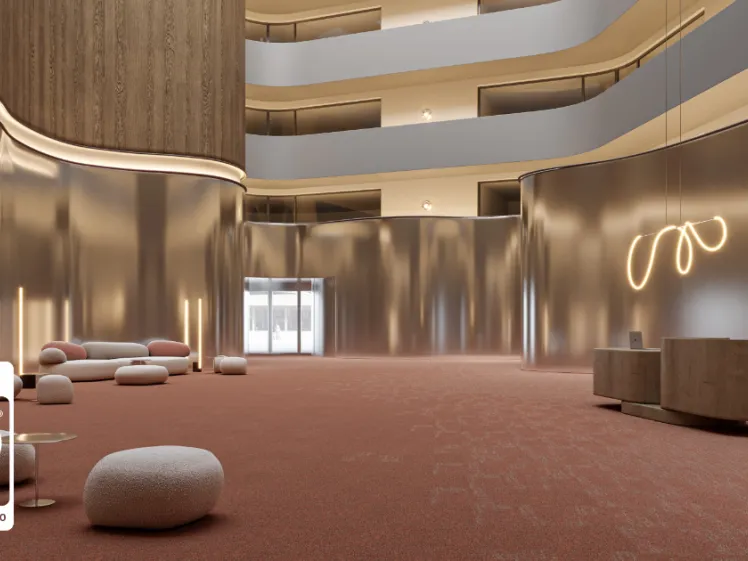
Neuroaesthetic design stands at the intersection of neuroscience and aesthetics. It’s about designing spaces with an understanding of how our brains respond to certain aesthetic choices, such as flooring. The use of soft flooring can shape emotions, enhance well-being, and redefine spaces. But how?
The Role of Flooring in Enhancing Emotional and Cognitive Responses
Flooring is more than just a surface; it’s a true sensory experience that can change the outlook and functionality of a space. Your choice of floor covering can significantly impact the end result. The texture, colour, and pattern of soft flooring trigger our emotional responses, making it the foundation of your spatial design.
Some may assume that choosing soft flooring is simply a matter of deciding between carpet tiles and broadloom, but there’s much more to consider. Depending on the functionality and atmosphere the space should convey, the choice of the corresponding texture, colour, and pattern should be the first design decision.
How Can Soft Flooring Have a Positive Impact on Well-Being?
Biophilia: Connecting People with the Outside
A article published in the International Journal of Environmental Research and Public Health (2023) found that exposure to natural elements in built environments significantly reduces cortisol levels (the stress hormone), leading to lower stress and anxiety. Biophilia addresses our need for the outside/natural world and helps to stimulate healthier and more productive spaces.
Biophilic design isn’t just about adding plants to your spaces, it also includes design elements like soft flooring with patterns that mimic natural phenomena. A great example of these carpet solutions is our Handcraft collection. Its designs - Moss, Leaf, Willow, and Grind - live up to their names by resembling the beauty of these elements.
Acoustic Benefits of Flooring: Noise Control
Soft flooring proves to be the perfect neuroaesthetic flooring solution for spaces where noise can become overwhelming and disruptive, but why?
The World Health Organization has acknowledged that noise can significantly impact the mental and physical health of people at all life stages. In offices, for instance, noise negatively impacts stress levels and in turn, the productivity of the employees. A 2019 survey by the Remark Group, titled “Noise and Wellbeing at Work,” surveyed 1,000 UK-based office workers and found that 65% of respondents felt workplace noise affected their ability to work, 44% reported a serious impact on their well-being, and 40% said it caused them stress.
Carpet, in particular, is an effective solution for noise reduction as it absorbs airborne sound, minimises impact noise, and reduces echo within a space. Research shows that carpets can lower impact sounds by 15-25 decibels, significantly improving acoustic comfort. The dense fibres trap sound waves, preventing them from bouncing off hard surfaces, while an added underlay further enhances sound absorption. makes carpet a practical choice for offices and other environments where noise control is essential for well-being and productivity.
Source: World Health Organisation, Regional Office for Europe, “Health Topics, Noise”, This (https://www.who.int/europe/news-room/fact-sheets/item/noise)
Functional Aesthetic Design
Contrary to common perception, functional design can equally be aesthetically pleasing. By considering flooring as a key element in the design process, you can seamlessly address both functional and aesthetic needs. A couple of examples of blending functionality with aesthetics through soft flooring:
Customisable flooring: this allows for designers to tailor patterns, colours, and textures to suit a brand’s identity or a specific design vision. This enhances the atmosphere and provides practical solutions like integrating company logos or thematic aesthetics into the flooring. With custom carpet flooring, designers are able to create visually striking layouts, making the flooring an integral part of the spatial design.
Creation of zones: Within open-plan offices, hotels, or educational settings, soft flooring can be used to define different functional areas. By using a creative design approach by adding carpet tiles in different colours and textures, designers are able to subtly separate workspaces, collaboration areas, and relaxation zones without the need of material barriers.
Wayfinding purposes: soft flooring can serve as an intuitive wayfinding tool, guiding people through large commercial spaces like offices, hospitals, or airports. By using contrasting carpet colours or patterns, or subtle gradients, geometric shapes, or creative motifs, designers can enhance visual appeal while providing clear navigation cues.
We can conclude that neuroaesthetic design through soft flooring not only enhances people’s well-being but also allows for designers to let their creative side shine through their spatial design.

Get a feel for our carpets

Get news and insights
Recent blog items

modulyss achieves Cradle to Cradle Certified® Gold under Version 4.0

From Grid to Flow: Designing Beyond Straight Lines

Perceptive Places: Shaping Smarter Interiors




